As a lover of landscape photography, I’ve always had a bit of a soft spot for small wide-angle primes. This is why I was very excited when we had the chance to test out the premium Panasonic Leica DG Summilux 15mm f/1.7, a semi-wide angle lens for the Micro Four Thirds system.
Unfortunately, during the two weeks I had with the lens, the Welsh coast was hit with the remnants of not one, but two large storms off the Atlantic, causing gail-force winds, flooding, persistent heavy rain and what people have called “Foamageddon,” referring to the huge amounts of snow-like sea foam that engulfs the promenade on a daily basis. So, be forewarned: you may see quite a bit of wild weather in this review!

Sea foam engulfs the promenade!
Build and Design
The Panasonic 15mm f/1.7 (equivalent of 30mm on full-frame) may be one of the smaller primes for the Micro Four Thirds system, but it has been built to a very high standard. It is the fourth lens designed in cooperation with Leica and has all the characteristics of a premium lens including a solid metal/plastic build and two ribbed rings to control aperture and focus.
It is comprised of 9 elements arranged in 7 groups (including 3 aspherical elements), an iris diaphragm with 7 rounded aperture blades, and Nano Surface Coating to minimise ghosting and flare.
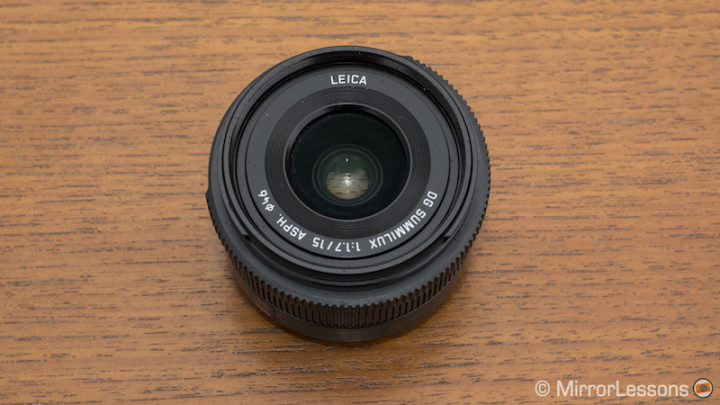
The aperture ring toggles between manual control with values from f/1.7 and f/16 and automatic control, indicated by an A. It is nicely damped and clicks as you change the aperture value. Though the clicking mechanism is good for still photography, it would be nice if you could de-click the aperture ring for video shooting. It should also be mentioned that the aperture ring only works on Panasonic bodies, something that Olympus users might find disappointing.
The focus ring, too, is smooth and accurate but lacks a distance scale on the barrel.
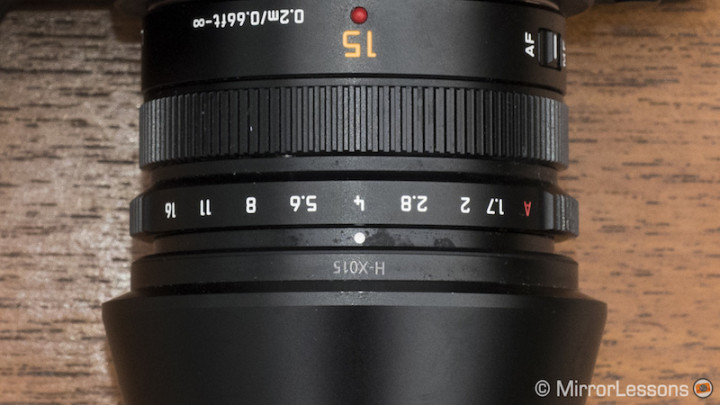
On the left side of the lens is a small AF/MF switch you can use to quickly switch between autofocus and manual focus.
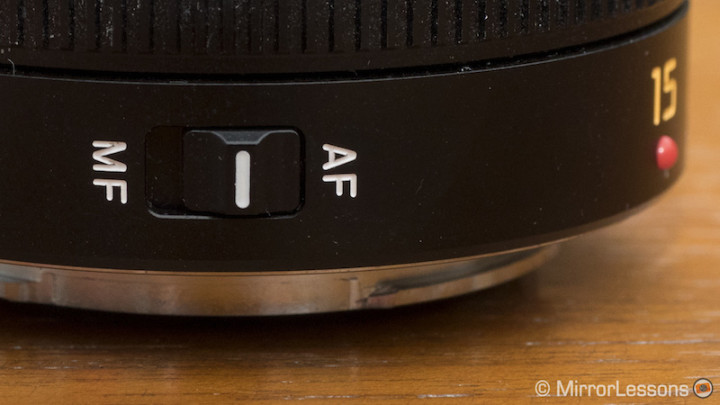
Another nice addition is the round bayonet lens hood. When attached, you cannot use the lens cap. However, Panasonic had to forethought to include an additional rubber lens cap that you can place on the hood to protect the front element.
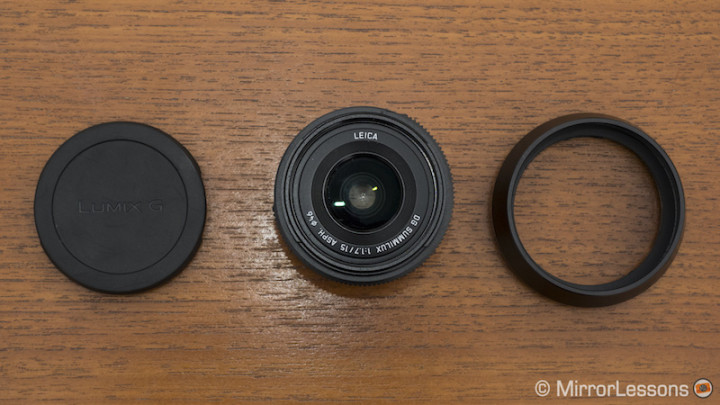
The lens weighs just 115 grams and is a mere 36cm in length, making it a good fit for all Micro Four Thirds cameras, even the smallest models like the Lumix GM5. It isn’t stabilised or weather-sealed but this isn’t a surprise as most small Lumix primes aren’t and adding these features probably would have made the lens bigger and bulkier. To protect the lens down at the seafront where the sea foam was flying in all directions, I used the very simple yet effective Op/Tech rain sleeve (see review here).
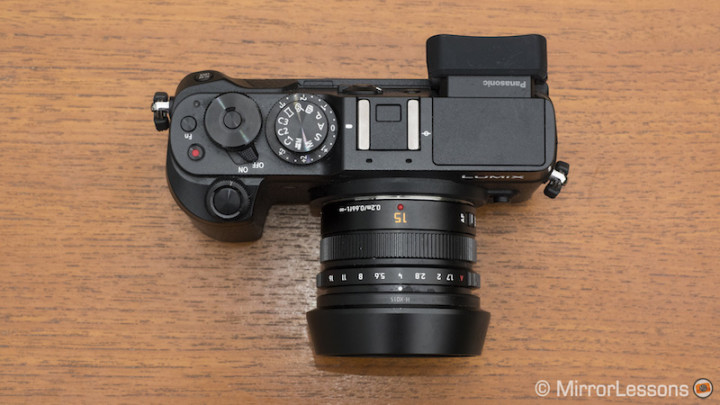
Image Quality – Through the lens

Post-processed with Rebecca Lily Presets
Sharpness
In the case of lenses with very fast apertures, there is often a noticeable decrease in sharpness before f/2.8. Not so with the 15mm f/1.7. The lens is almost as sharp at the centre at f/1.7 as it is at f/2.8, which in turn, is nearly as sharp as the sharpest aperture of f/4. It continues to perform well up to f/8, after which diffraction begins to rear its ugly head (a common occurrence with Micro Four Thirds lenses). f/11 is useable while f/16 is noticeably soft.




Moving on to corner and edge sharpness, the 15mm’s performance tends to peak between f/4 and f/5.6 but any value between f/2.8 and f/11 is quite useable. The performance at f/1.7 is decent while f/16 should generally be avoided.


Post-processed with Rebecca Lily Presets


You can see a full series of high-res test shots taken at the various apertures in our SmugMug gallery.
Bokeh
Since the 15mm has seven rounded aperture blades, it is capable of producing what we’d consider a very smooth and pleasant bokeh at the fastest apertures. The specular highlights are nice and round in the centre but begin to take on a “cat’s eye” shape as they get closer to the edges of the frame.

Post-processed with Rebecca Lily Presets

Chromatic Aberration
Chromatic aberration isn’t really an issue at any aperture, not even the fastest aperture of f/1.7. Even when it does appear, you can easily remove it in post-production with a program like Lightroom.

Flare
The flare produced by the 15mm is quite mild and comparable to that produced by other Micro Four Thirds primes. You might see a mix of purple veiling flare, polygonal shapes and bright streaks depending on the sun’s position in your image. Of course, having a lens hood helps to reduce flare, so it is great to see that Panasonic has opted to include one.



Vignetting
Vignetting, or light fall-off, makes an appearance at the fastest aperture of 1.7. Once you stop down to f/4, it all but disappears. Keep in mind that vignetting can also be easily corrected in a post-production software like Lightroom.
Distortion
Since software distortion correction is automatically applied in-camera, you won’t see much barrel distortion from the 15mm except in shots featuring a straight horizon line, such as the seascapes I’ve shown throughout this article. In truth, it is hardly relevant in the real world but if you do see some distortion you’d like to correct, you can rely on the correction tools in Lightroom.
Below you can find examples of very mild distortion and vignetting found within the same image.
Focusing
On modern mirrorless cameras like the Lumix GX8 and OM-D E-M1, focussing is very quick and accurate in good light and only a tad slower in poor light conditions. It also has a perfectly silent autofocus motor, so discretion is never an issue. Manual focussing, too, is a pleasure thanks to the ribbed focus ring, which is neither too large nor too small. Although it is fly-by-wire, it is very accurate and easy to use in conjunction with the various manual assists (peaking and magnification) that modern mirrorless cameras offer.
The 15mm can focus as close as 20cm with a maximum magnification of 0.1x. It isn’t a macro lens by any means but if you use the fastest apertures, you can take some nice close-ups with a pleasant out of focus background. Below are a couple of practical examples that show how close you can get.

Taken at minimum focus distance

Taken at minimum focus distance
Price
The Panasonic Leica 15mm f/1.7 entered the market at $599 and since its release, it has come down in price. The lowest I’ve seen it for is just under $400, making it quite an affordable prime for the quality you get. If you often take a mix of landscape and street photography, the 15mm is an excellent prime to have in your arsenal of lenses.
Conclusion

The Panasonic Leica 15mm f/1.7 is a lens with many merits. Besides boasting a handy focal length for both street and landscapes, it is extremely small, light and compact. It benefits from a handful of nice features such as a very fast aperture, clicking aperture ring, MF/AF switch, close focussing capabilities and a beautifully designed lens hood, and to top it all, it isn’t particularly expensive these days.
Would I personally buy this lens? Probably not, as I already own the M.Zuiko 12-40mm f/2.8 professional zoom, which covers all my wide-angle and mid-range needs in one package. Likewise, I doubt that someone who already owns the Lumix 12-35mm f/2.8 would place the 15mm high on his or her list of priorities. However, if you prefer small primes to larger zooms or feel you would benefit from the fast aperture, the 15mm is a lens I wouldn’t hesitate to recommend.
 What I like about the Panasonic Leica 15mm f/1.7
What I like about the Panasonic Leica 15mm f/1.7
- A useful focal length for landscapes and street photography
- Very good sharpness from the fastest aperture
- Small and light with an excellent build
- Nice clicking aperture ring and smooth focus ring
- Good close focussing capabilities
- Comes with a metal lens hood and rubber lens cap for the lens hood
 What I don’t like about the Panasonic Leica 15mm f/1.7
What I don’t like about the Panasonic Leica 15mm f/1.7
- Lacks optical stabilisation and weather resistance (but these features would admittedly add bulk to the lens)
- It would be nice to have a de-clicking aperture mechanism for video
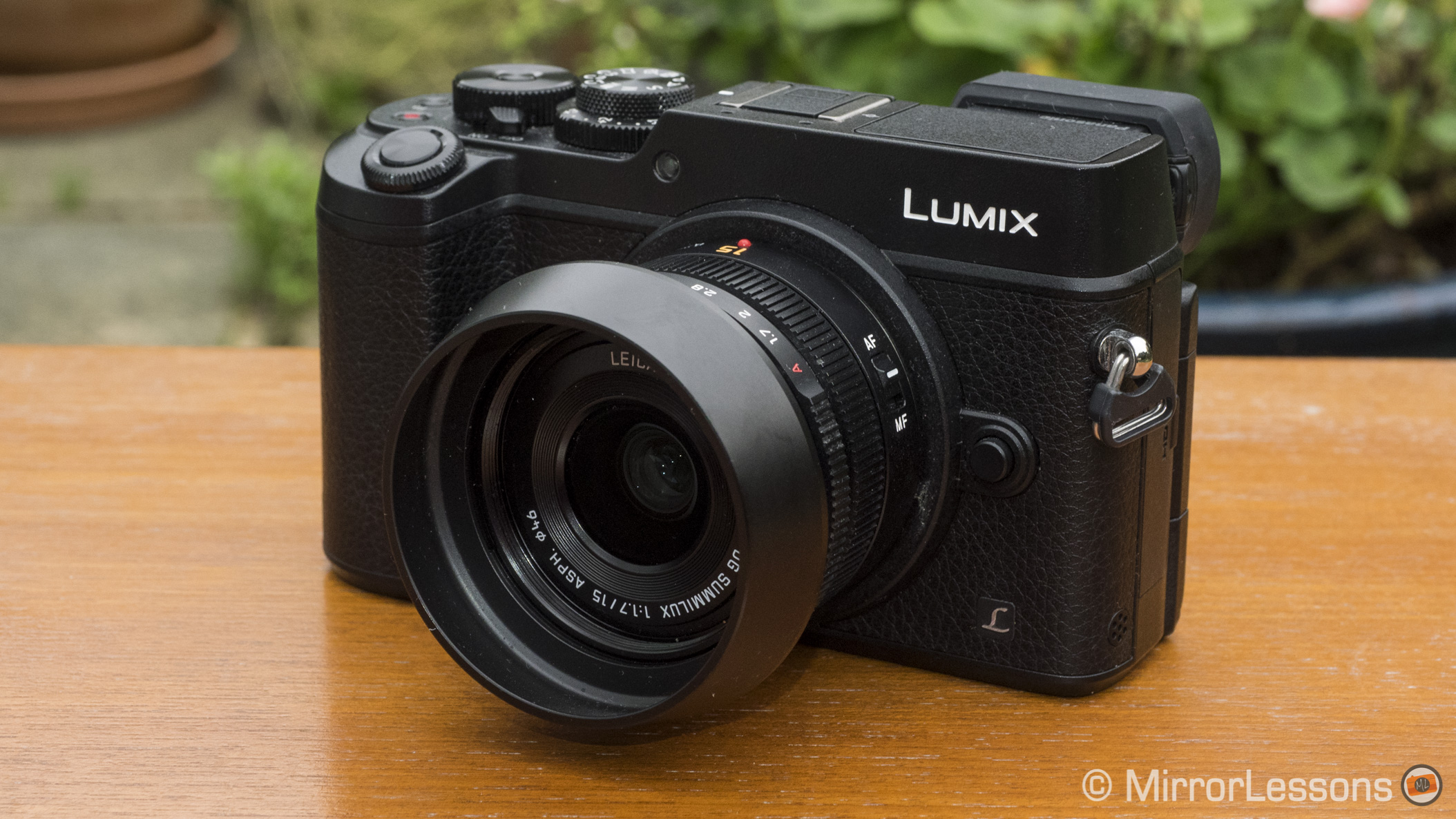

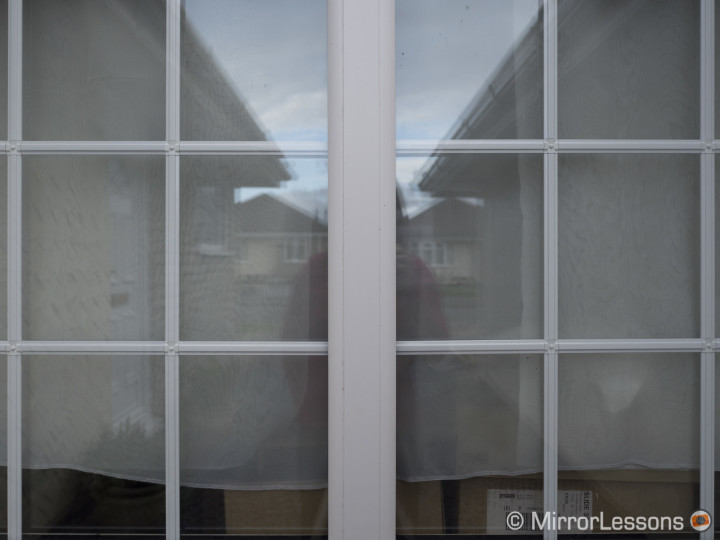
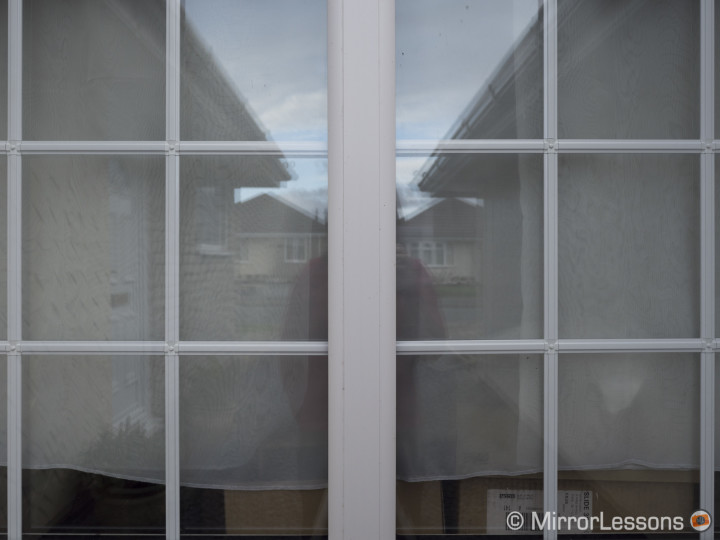
Hi everyone,
Thanks for this great review and the others too !
I own this little 15MM PL and it’s my walkaround lens with the small EM10ii. The package is very lightweight, so it comes with me all around and every day! ( As i started a 365 Project)
It’s a really sharp lens even if i find the Oly 25mm 1.8 sharper.
For street photo i prefer the Oly 25mm 1.8. And for the landscapes, my favourite is really the Pana Leica 8 18. Its sharpness is just incredible.
The 20mm (1st edition) has been my very first m4/3 lens, came with my beloved GF1 back in 2010. It’s also been my ONLY lens for more than one year. I always loved it and still use it with my GX7 and GX8 (and GF1 sometimes!). The only flaw is focusing. It’s the slowest and noisiest you can get on the system…(and also the front of the lens moves back and forth). If you can deal with this, it’s absolutely a no brainer, especially at nowadays prices, but for fast focusing need, like street, not that much…That’s why I’m lusting over the 15mm…I actually always wondered why Panasonic made this lens so clumsy focusing…the 14mm f/2.5, which is similar as per build and period, is lightning fast…
Sadly we haven’t, but I’ve only come across positive reviews of the 20mm and seem to be quite similar optically speaking. The important thing is to go for the focal length you feel you’ll use the most!
Hi Heather, I read this review again now as I am looking to buy gx80 with a walkaround lens. I am thinking between this 15mm and 20/1.7.Did you get a chance to use 20mm? I wonder which is better optically. I am comfortable with both these focal lengths. I think 20mm would be more versatile as it is wide enough but also could be used for environmental portraits more so than the 15mm. Thanks very much…
Thanks for the review. I had my E-P5 modified for full color IR and the little powerhouse 15mm also gives great IR images! No hot spots and sharp corner to corner.
I bought the 17mm first. I should probably sell the 17mm but I haven’t brought myself to do it. It’s a great lens but I feel the 15mm has something extra.
I do prefer the 17mm for people. I have to pay more attention to subject distance with the wider 15mm.
I have the same situation with the 45mm 1.8. It’s been overshadowed by the PL 42.5mm but it’s so small, light and good I’m still holding on to it. 🙂
I’ve owned both ( surprise surprise !!) and the Olympus is a nice lens but the Panasonic shades it for me. Must be that Leica branding. I doubt they make any part of it, but something must rub off, since all the best m4/3 lenses optically seem to have it. Doesn’t mean that others aren’t more useful though.
‘I’m quite jealous of your lens collection! :)’
If only my bank manager and accountant felt the same!!!!!
LOL! The lens is cool! But the foam is amazing! 🙂
You’re very welcome! Gordon is a true reference, and a really nice person too. Thanks for the kind words!
Thanks for that! Gotta love Gordon and CameraLabs… Between both your sites helped me make a decision to (for the most part) ditch the DSLR for 90% of my photography. Keep up the amazing work! Always looking forward to continuous reading of your blog.
Good choices! (It’s hard to stop using the 7-14mm!) What made you go for both the 15mm and the 17mm?
I doubt we’ll get the chance to compare them but Gordon of CameraLabs carried out a good comparison: http://www.cameralabs.com/reviews/Panasonic_Leica_DG_Summilux_15mm_f1-7_H-X015/Leica_15mm_vs_Olympus_17mm.shtml
The lens? Or the foam? Hehe. 🙂
I know what you mean! I always try to pack a maximum of 2-3 lenses so that I don’t feel overwhelmed by the choice. 🙂
I’m quite jealous of your lens collection! 🙂 I’m always drawn to the 12-40mm for its versatility but the size and aperture can be limiting in certain situations.
Good review. I’d like to see how it compares to the Olympus 17mm 1.8 prime. Another good lens in a similar class.
This lens has gradually become my favorite. I have the 12-35mm 2.8, 7-14mm 4.0 and the 17mm 1.8 (which are great) but I’ve been mostly using the 15mm 1.7. I’m not sure what makes the difference but I get more keepers in Lightroom with the 15mm.
Depends…I find that I will throw the Oly 45mm in another pocket as it is so small and light, too…and with a little Pen body (EPL-6 w/VF4) and the 15mm I have a lot of fire power and that photography is really just FUN again.
I also go out with OMD’s and a bag FULL of lenses (or for that matter, with FF equipment, too)…but sometimes I have too many choices and get “locked-up”. LOL!
Hi Bob, and thanks for commenting! 🙂 I completely agree that primes make you think more about your composition, and 15mm on MFT is such a versatile focal length that you can do almost anything with it, from landscape to street to even environmental portraiture. Do you find that you pack both the 12-40 and the 15mm when you go out, or do you generally choose just one or the other?
Thank you, Gary! I always use a small air pump after each outing to blow dust off the sensor and the lens. It’s kept our cameras clean so far. 🙂
Nice, balanced review.
Funny…I own the Oly12-40mm and this lens, too. …I bought the very unique “matt” silver version from the Asian market, as it was not offered for sale in The States. It’s quite beautiful…but what is great about this lens is it’s small size and it’s performance. A small MFT body with this lens on it is a very light, capable performer, with crystal clear low-light capability for when you want to go out light. The low DOF can come in handy, too. I find that when I am out shooting with a great prime like this it makes me dig deep and find images with this unique viewpoint that this lens can exploit to the fullest!
Nice review of the Pana/Leica 15mm f1.7, thank you Heather. It has been on my radar for quite some time, the sample pictures that I’ve seen so far really showed how much detail the lens can extract. I agree that the focal length is perfect for both street and landscape! Also, I love the sample pictures too 🙂
BTW, out of curiosity, how do you guys keep your cameras’ sensor free of dust? Judging from the amount of lens review, I imagine you guys must had swapped lens on the GX8 (and previously the E-M1) million times, but your sample pictures at f/8 and above didn’t show any dust spots! My GX7 at f/11 really shows all those dust spots in the pictures 🙁